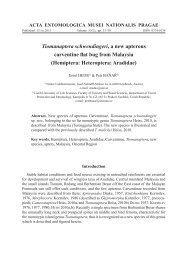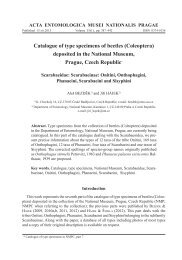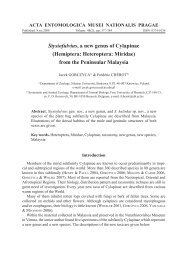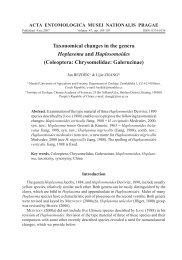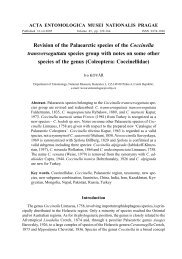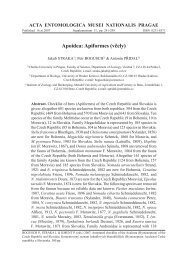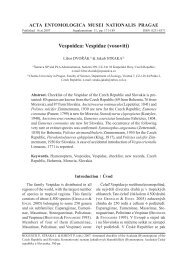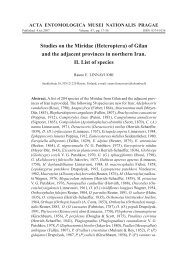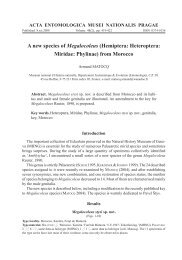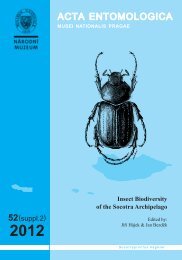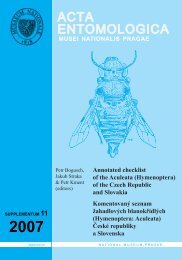A new species of the genus Glischrochilus - Acta Entomologica ...
A new species of the genus Glischrochilus - Acta Entomologica ...
A new species of the genus Glischrochilus - Acta Entomologica ...
You also want an ePaper? Increase the reach of your titles
YUMPU automatically turns print PDFs into web optimized ePapers that Google loves.
ACTA ENTOMOLOGICA MUSEI NATIONALIS PRAGAE<br />
Published 15.xii.2009 Volume 49(2), pp. 505–510 ISSN 0374-1036<br />
A <strong>new</strong> <strong>species</strong> <strong>of</strong> <strong>the</strong> <strong>genus</strong> <strong>Glischrochilus</strong><br />
(Coleoptera: Nitidulidae: Cryptarchinae)<br />
from China<br />
Andrzej LASOŃ<br />
ul.Wiejska 4B/85, 15-352 Białystok, Poland; e-mail: haptos@interia.pl<br />
Abstract. <strong>Glischrochilus</strong> (Librodor) jelineki sp. nov. from China is described and<br />
illustrated. Diagnostic characters <strong>of</strong> <strong>the</strong> <strong>new</strong> <strong>species</strong> and <strong>of</strong> <strong>the</strong> related <strong>Glischrochilus</strong><br />
(Librodor) japonius (Motschulsky, 1857) are fi gured.<br />
Key words. Coleoptera, Nitidulidae, Cryptarchinae, <strong>Glischrochilus</strong>, <strong>new</strong> <strong>species</strong>,<br />
taxonomy, China<br />
Introduction<br />
<strong>Glischrochilus</strong> Reitter, 1873, is a cosmopolitan <strong>genus</strong> <strong>of</strong> <strong>the</strong> subfamily Cryptarchinae<br />
(family Nitidulidae). It is distributed in <strong>the</strong> Holarctic and Oriental Regions. Within <strong>the</strong> limits<br />
<strong>of</strong> <strong>the</strong> Palaearctic Region, as considered in <strong>the</strong> recent catalogue <strong>of</strong> LÖBL & SMETANA (2007),<br />
<strong>Glischrochilus</strong> is represented by 32 described <strong>species</strong> (JELÍNEK & AUDISIO 2007). The <strong>species</strong><br />
<strong>of</strong> <strong>Glischrochilus</strong> from China were revised by JELÍNEK (1975). Additional <strong>species</strong> from this<br />
territory were described by JELÍNEK (1982, 1999) and KIREJTSHUK (1984, 1987). A key to <strong>the</strong><br />
<strong>species</strong> <strong>of</strong> <strong>the</strong> Indo-Malayan region, also including China, was published by KIREJTSHUK<br />
(1987).<br />
In <strong>the</strong> present paper, a <strong>new</strong> <strong>species</strong> <strong>of</strong> <strong>Glischrochilus</strong> from China is described. It belongs<br />
to <strong>the</strong> sub<strong>genus</strong> Librodor Reitter, 1884 as defi ned by JELÍNEK (1975).<br />
Material and methods<br />
Dry-mounted specimens were studied under a binocular stereomicroscope MBS-10. Measurements<br />
were made with an ocular micrometer. For <strong>the</strong> study <strong>of</strong> <strong>the</strong> genitalia, specimens<br />
were s<strong>of</strong>tened in 5% ammonia solution and subsequently dissected under <strong>the</strong> stereomicroscope.<br />
Genitalia were rinsed with water, <strong>the</strong>n transferred in propyl alcohol and embedded in a<br />
drop <strong>of</strong> Epural placed on <strong>the</strong> same label as <strong>the</strong> specimen. The SEM photographs <strong>of</strong> antennae,<br />
pygidia, head and prosternal process were made with a scanning microscope Hitachi S-3000
506<br />
LASOŃ: A <strong>new</strong> <strong>Glischrochilus</strong> from China (Coleoptera: Nitidulidae)<br />
N. O<strong>the</strong>r pictures were made using a Sony Alpha 700 camera (with Tamron AF SP 90 f/2.8<br />
lens, Rynox 250 convertor and Minolta R-1200 macro ring fl ash).<br />
The P/A index is defi ned as <strong>the</strong> ratio <strong>of</strong> <strong>the</strong> distance <strong>of</strong> posterior pronotal angles over <strong>the</strong><br />
distance <strong>of</strong> anterior pronotal angles.<br />
Taxonomy<br />
<strong>Glischrochilus</strong> (Librodor) jelineki sp. n.<br />
(Figs. 1– 9)<br />
Type material. HOLOTYPE: , CHINA: SHAANXI: Taibaishan National Park, 1350 m a.s.l., 10.vi.1999, M. Murzin<br />
lgt. (coll. National Museum, Praha, Czech Republic). PARATYPES: 2 , CHINA: HUBEI: Dahongshan, 31º50′N/<br />
113º00′E, 30.iv.–1.v.2005, J. Turna lgt (coll. National Museum, Praha (1 ) and coll. Andrzej Lasoń, Białystok,<br />
Poland (1 )).<br />
Diagnosis. Oblong oval, ra<strong>the</strong>r convex, moderately shining. Head, pronotum, scutellum, fore<br />
and middle tibia and elytra black, each elytron with two yellow-orange spots. Metasternum,<br />
abdomen, pygidium and hind femur (excluding trochanter) yellow. Prosternum including<br />
prosternal process, mesosternum, hind tibia, anterior and middle femora, all tarsi and antenna<br />
brown (Figs. 1–3).<br />
Description. Length 8.0–9.8 mm (holotype 8.0 mm), width 3.5–4.5 mm (holotype 3.5<br />
mm)<br />
Male (holotype). Head across eyes almost as wide as <strong>the</strong> distance between anterior pronotal<br />
angles, eyes moderately convex. Frons fl at, punctures between eyes deep, ra<strong>the</strong>r coarse and<br />
sparse, markedly larger than eye facets, separated by one diameter or less. Punctures in middle<br />
and anterior portions <strong>of</strong> frons smaller and sparser, separated by 1.5–2.0 diameters (Fig. 4).<br />
Antennae almost as long as <strong>the</strong> distance between insertions <strong>of</strong> antennae. Antennal club about<br />
1.55 times as long as wide (Fig. 5).<br />
Pronotum widest at basal third, slightly narrowed posteriorly, 1.74 times as wide as long,<br />
P/A index 1.26. Anterior margin subtruncate, not bordered, anterior angles acute, prominent.<br />
Base <strong>of</strong> pronotum somewhat narrower than elytra, subtly bordered, with broad and ra<strong>the</strong>r<br />
shallow, arcuate emargination next to each posterior angle, <strong>the</strong> latter obtuse, not prominent,.<br />
Sides broadly arcuate, narrowly canaliculate. Surface transversely convex, punctures in <strong>the</strong><br />
middle <strong>of</strong> pronotum much fi ner than those <strong>of</strong> frons, separated by 1.0–2.0 diameters, becoming<br />
gradually larger and closer laterally, at lateral border separated by less than half a diameter,<br />
spaces between <strong>the</strong>m microscopically rugose, moderately shining. Scutellum rounded posteriorly,<br />
with punctures separated by one diameter or less.<br />
Elytra widest at about one third <strong>of</strong> <strong>the</strong>ir length, 1.22 times longer than <strong>the</strong>ir combined width,<br />
broadly transversely convex, ra<strong>the</strong>r widely rounded apically. Humeral angles subrectangular,<br />
somewhat rounded, bluntly dentate. Sutural angle subrectangular, sutural lines faintly marked<br />
only at apex. Lateral margins fl atly arcuate, narrowly explanate (almost as wide as antennal<br />
fl agellum). Surface <strong>of</strong> elytra microscopically longitudinally striate (particularly near apex),<br />
punctures smaller and shallower than those <strong>of</strong> pronotum, separated by 2.0–3.0 diameters,<br />
becoming somewhat closer, separated by 1.0–2.0 diameters laterally and around scutellum.<br />
Each elytron (Figs. 1–2) with two yellow-orange spots: anterior spot with four branches, <strong>the</strong>
<strong>Acta</strong> <strong>Entomologica</strong> Musei Nationalis Pragae, 49(2), 2009 507<br />
Figs. 1–8. <strong>Glischrochilus</strong> jelineki sp. nov. 1–2 – dorsal view (1 – male, holotype; 2 – female, paratype); 3 – ventral<br />
view (female); 4 – head (male); 5 – antenne (male); 6 – mesosternum and prosternal process (male); 7–8 – pygidium<br />
and apex at elytra (7 – male, 8 – female).
508<br />
LASOŃ: A <strong>new</strong> <strong>Glischrochilus</strong> from China (Coleoptera: Nitidulidae)<br />
Figs. 9–10. Male genitalia (median lobe left, tegmen right). 9 – <strong>Glischrochilus</strong> jelineki sp. nov. (holotype);<br />
10 – G. japonius (Motschulsky, 1858) (China: Sichuan).<br />
outer anterior branch reaching elytral base and humeral bulge, <strong>the</strong> second branch shorter,<br />
and projecting posteriorly into two short lobes (<strong>the</strong> outer lobe subtriangular); posterior spot<br />
transverse, with four branches. Pygidium broadly rounded at apex, densely punctate, punctures<br />
large, separated mostly by less than one diameter (Fig. 7).<br />
Postmentum in <strong>the</strong> middle part <strong>of</strong> posterior margin bordered, smooth and shining, fi nely<br />
distinctly punctate only near genae, <strong>the</strong> latter rugose. Middle portion <strong>of</strong> prosternum with<br />
transverse wrinkles, convex, shallowly concave laterally. Punctation <strong>of</strong> prosternum irregular,<br />
punctures medially fi ne and sparse, much larger and becoming gradually rugose laterally.<br />
Prosternal process fl at, narrowly bordered laterally, broadly rounded distally, apical part only<br />
fi nely punctulate, dull (Fig. 6). Posterior margin <strong>of</strong> mesosternum between mesocoxae broadly<br />
and arcuately emarginate. Mesocoxal lines closely bordering entire posterior margin <strong>of</strong> coxal<br />
cavities. Metasternum fl attened in median portion, with mediolongitudal impunctate depression<br />
behind midlength; anterior intercoxal process moderately bulged, impunctate. Punctures in
<strong>Acta</strong> <strong>Entomologica</strong> Musei Nationalis Pragae, 49(2), 2009 509<br />
<strong>the</strong> middle <strong>of</strong> metasternum fi ne, nearly equal in size to eye facets, separated by 1.0–3.0 diameters;<br />
punctures at sides somewhat larger and denser, separated by about one diameter and<br />
bearing recumbent hairs. Punctures <strong>of</strong> abdominal sterna slightly larger and closer than those<br />
<strong>of</strong> metasternum (much closer posteriorly), punctures in lateral areas with recumbent hairs.<br />
Metacoxal lines divergent behind posterior margin <strong>of</strong> coxal cavities. Hypopygium fl attened,<br />
apical margin with two arcuate emarginations.<br />
Pro-, meso- and metatibia subtriangular with acute outer apical angle. Outer edge <strong>of</strong> fore<br />
tibia feebly dentate, outer edge <strong>of</strong> middle and hind tibia with several short thorns separated<br />
by 2–4 <strong>the</strong>ir lengths. Fore tarsus dilated, reaching almost two thirds <strong>of</strong> maximum width <strong>of</strong><br />
anterior tibia.<br />
Male genitalia as in Fig. 9.<br />
Female. In general appearance similar to male. Outline <strong>of</strong> body more regularly oval. Pygidium<br />
narrower and more strongly rounded at apex (Fig. 8). Elytral spots similarly shaped but<br />
much larger. Anterior spot reaching base <strong>of</strong> elytron and occupying <strong>the</strong> entire space between<br />
scutellum and humeral bulge (inside with small circular black spot). Posterior spot much wider<br />
and with more branched margin. Pronotum widest before posterior angles, slightly narrowed<br />
posteriorly, 1.78–1.80 times as wide as long, P/A index 1.43–1.46. Elytra 1.13–1.20 times<br />
as long as <strong>the</strong>ir combined width.<br />
Differential diagnosis. The <strong>new</strong> <strong>species</strong> is probably closely related to G. (L.) japonius<br />
(Motschulsky, 1858) from <strong>the</strong> East Palaearctic and Oriental Regions. However, G. japonius<br />
mainly differs by a yellowish colour <strong>of</strong> <strong>the</strong> pygidium, metasternum and abdomen, differently<br />
shaped elytral spots (Figs. 1–2; see also Figs. 43–44 in JELÍNEK (1975)) and more laterally<br />
directed pre-apical projections <strong>of</strong> <strong>the</strong> median lobe (Fig. 9). The colouration <strong>of</strong> <strong>the</strong> metasternum<br />
and abdominal sternites resembles G. (L.) latior Jelínek, 1999 from sou<strong>the</strong>rn China, but <strong>the</strong><br />
latter exhibits a different shape <strong>of</strong> elytral spots and more strongly projecting lateral pre-apical<br />
projections <strong>of</strong> <strong>the</strong> median lobe.<br />
Etymology. The <strong>new</strong> <strong>species</strong> is dedicated to my friend and preceptor, prominent Czech<br />
entomologist Josef Jelínek (Praha, Czech Republic).<br />
Distribution. Central China (Hubei and Shaanxi provinces).<br />
Acknowledgements<br />
I would like to express my thanks to Tomasz Koziółkiewicz (Polytechnic <strong>of</strong> Bialystok,<br />
Poland) for making <strong>the</strong> SEM photographs.<br />
References<br />
JELÍNEK J. 1975: Revision <strong>of</strong> <strong>the</strong> <strong>genus</strong> <strong>Glischrochilus</strong> Reitter from <strong>the</strong> Oriental region and China (Coleoptera,<br />
Nitidulidae). <strong>Acta</strong> <strong>Entomologica</strong> Bohemoslovaca 72: 127–144.<br />
JELÍNEK J. 1982: New and little known taxa <strong>of</strong> Nitidulidae (Coleoptera). <strong>Acta</strong> Musei Nationalis Pragae, B 38:<br />
171–199.<br />
JELÍNEK J. 1999: New <strong>species</strong> <strong>of</strong> <strong>the</strong> <strong>genus</strong> <strong>Glischrochilus</strong> (Coleoptera: Nitidulidae: Cryptarchinae) from Asia.<br />
Folia Heyrovskyana 7: 201–216.
510<br />
LASOŃ: A <strong>new</strong> <strong>Glischrochilus</strong> from China (Coleoptera: Nitidulidae)<br />
JELÍNEK J. & AUDISIO P. 2007: Family Nitidulidae. Pp. 459-491. In: LÖBL I. & SMETANA A. (eds.): Catalogue<br />
<strong>of</strong> Palaearctic Coleoptera. Vol. 4. Apollo Books, Stenstrup, 935 pp.<br />
KIREJTSHUK A. G. 1984: New taxa <strong>of</strong> Nitidulidae (Coleoptera) from <strong>the</strong> Indo-Malayan fauna. Annales Historico–Naturales<br />
Musei Nationalis Hungarici 76: 169–195.<br />
KIREJTSHUK A. G. 1987: Obzor Zhukov-blestyanok podsem. Cryptarchinae (Coleoptera, Nitidulidae) Indo-Malayskoy<br />
oblasti. [Review <strong>of</strong> <strong>the</strong> nitidulid beetles <strong>of</strong> <strong>the</strong> subfamily Cryptarchinae (Coleoptera, Nitidulidae) from<br />
<strong>the</strong> Indo-Malayan region]. Trudy Zoologicheskogo Instituta Akademii Nauk SSSR 170: 62–95 (in Russian).<br />
LÖBL I. & SMETANA A. (eds.) 2007: Catalogue <strong>of</strong> Palaearctic Coleoptera. Vol. 4: Elateroidea – Derodontoidea<br />
– Bostrichoidea – Lymexyloidea – Cleroidea – Cucujoidea. Apollo Books, Stenstrup, 935 pp.



